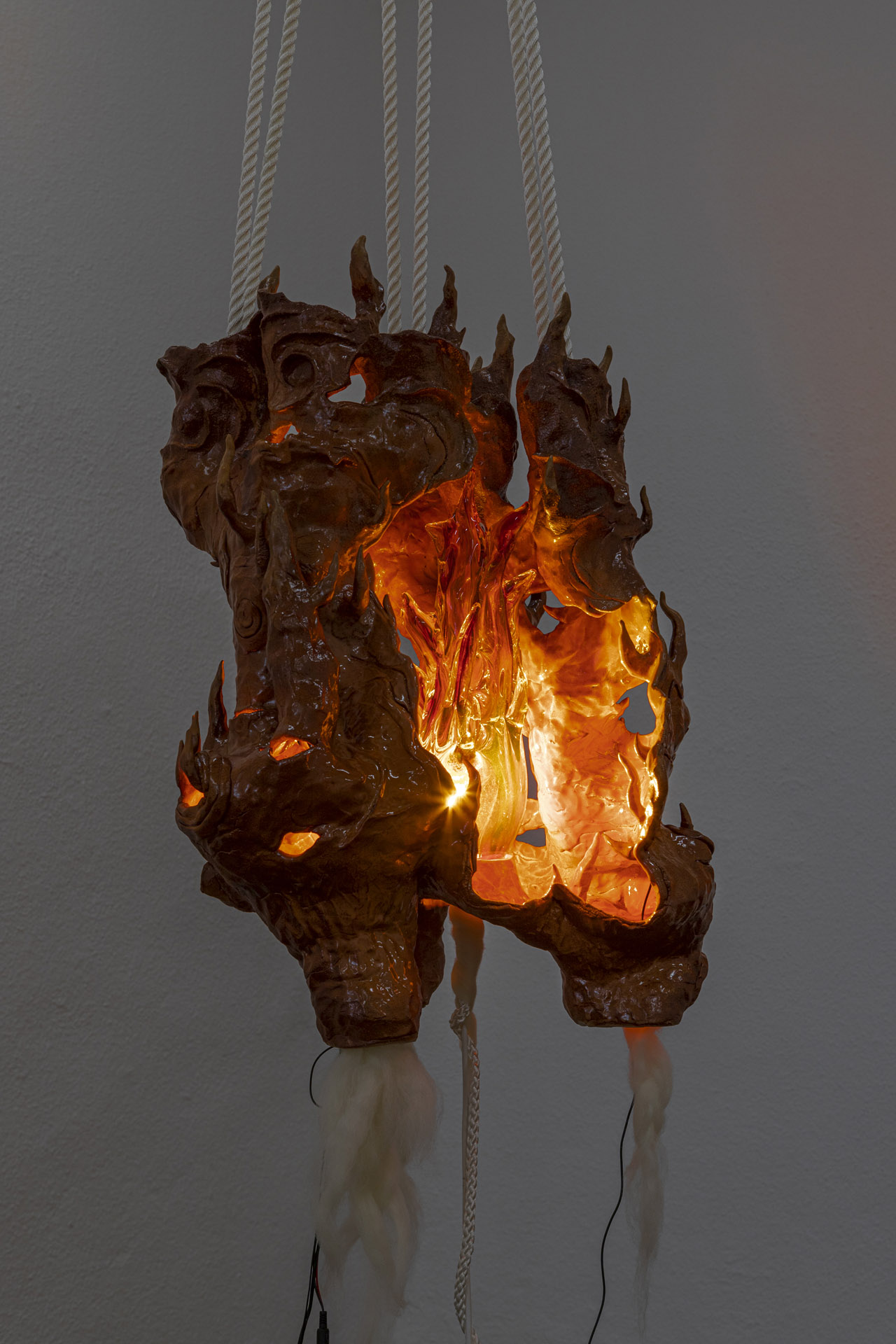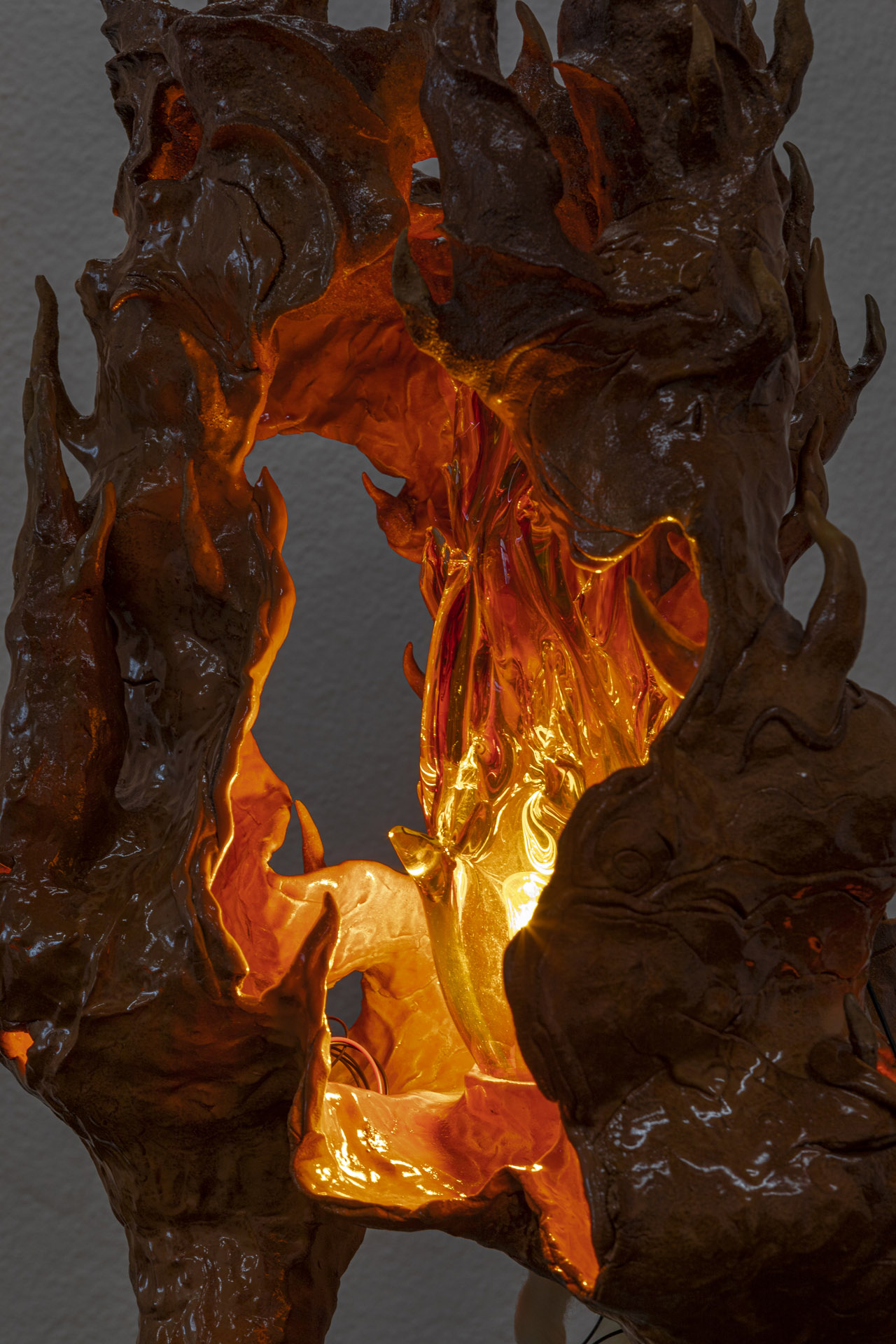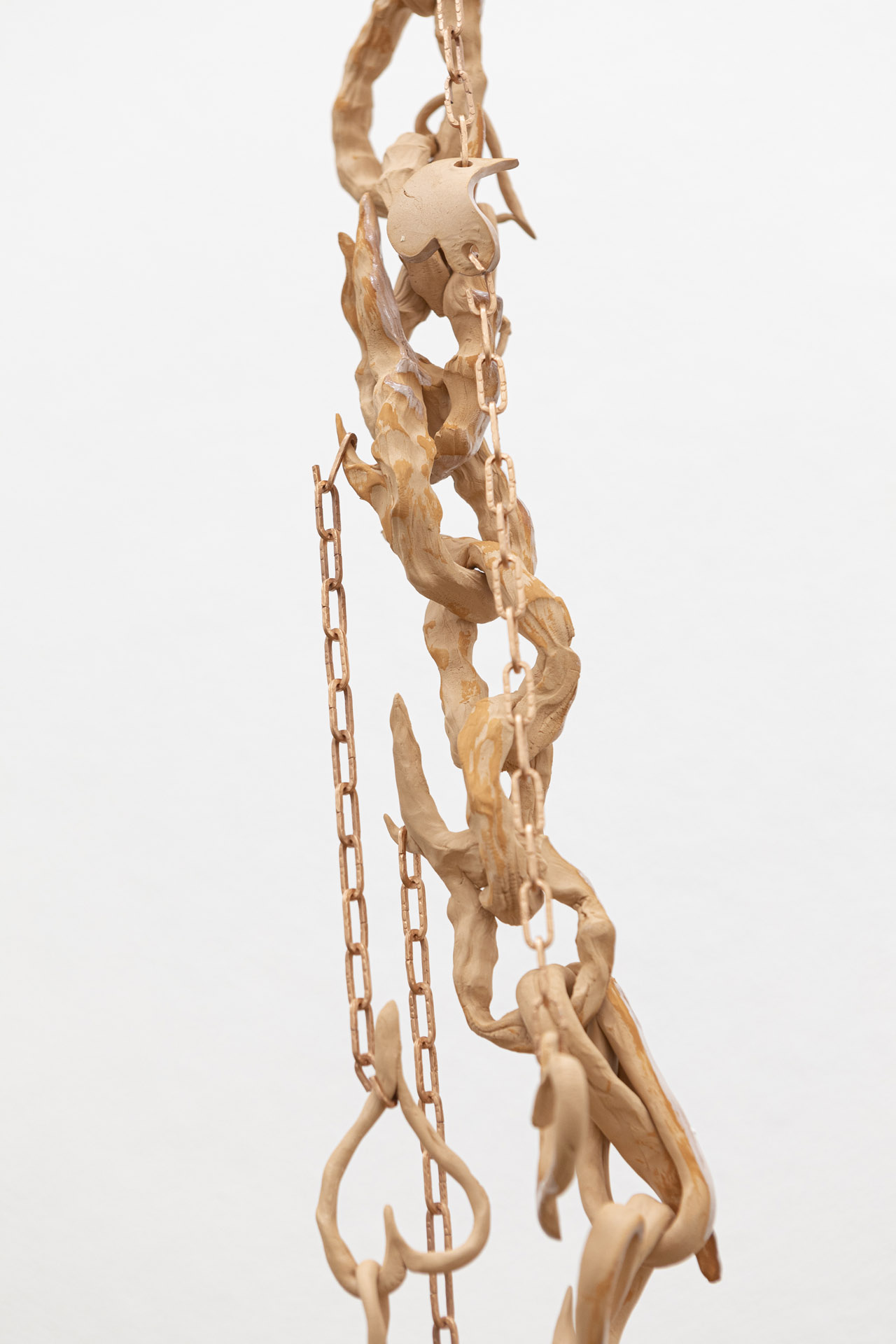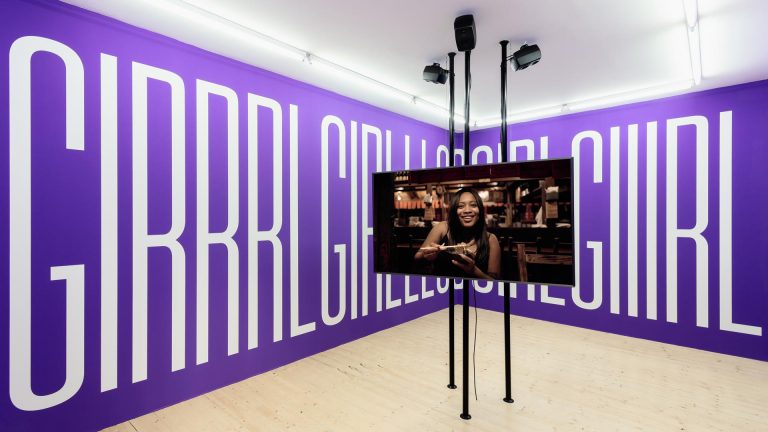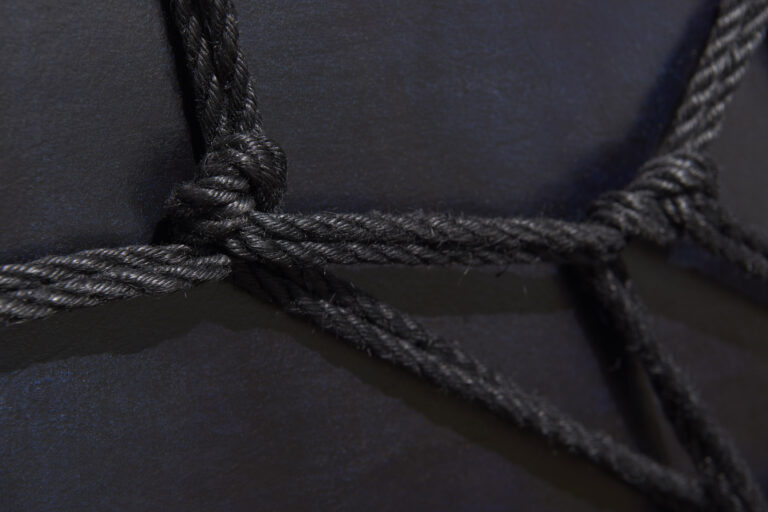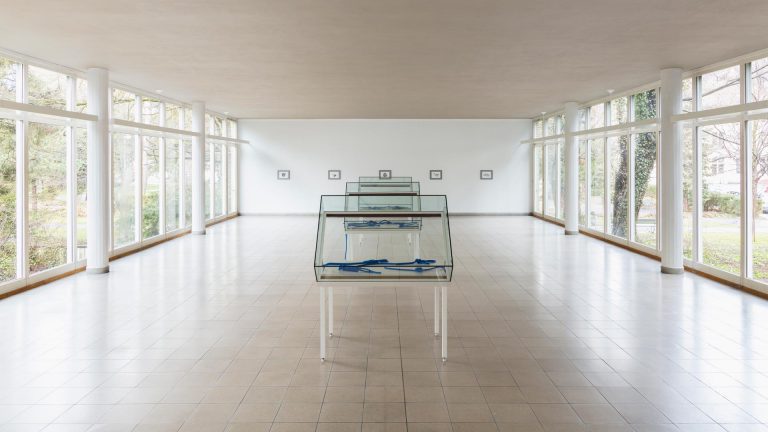Artists: Maya Hottarek, Julian Zehnder
Exhibition title: Isomorphous Drip
Venue: KRONE COURONNE, Biel/Bienne, Switzerland
Date: October 29 – December 4, 2021
Photography: all images copyright and courtesy of the artists and KRONE COURONNE, Biel/Bienne
What if it all started with a drip? Like the beginning of a story. Or perhaps its conclusion. The drip as the embodiment of change. Originating in liquid environments, the drip travels from one container to another. It morphs to eventually take the form of its habitat, keeping its symbolic shape along the way.
Fluidity as a quality of liquids offers itself as a leading metaphor for the state of the modern era. Temporary. In transit. The relation between the values of durability and transience is reversed. This mobility is associated with lightness. Change is the only permanence. Uncertainty is the only certainty. What unites different forms of modern life is their fragility, temporariness, vulnerability and inclination to constant change.
The drip is a connecting thread in Maya Hottarek and Julian Zehnder’s exhibition at KRONE COURONNE. ISOMORPHOUS DRIP takes up the idea that elements are naturally pushed together to transform and merge into new entities. “ISO-” means “equal, similar” in ancient Greek. The practices of Maya Hottarek and Julian Zehnder diverge in their exploration of materials, yet are blending within the exhibition. They drip into each other, forming a new ensemble, an experience. They become the host or the inhabitant, and vice-versa.
Working together. Working apart. Working towards a result. Working with no aim. Procrastinating. Taking pleasure in every minute. Taking a breath. Changing gear. Working late into the night. Collaboration is in a way a performance. When in dialogue or collaborating, we exchange promises. We flirt. We play. Can working together be a survival strategy?
In the work zen spice mandala, a motor attached to the ceiling rotates around its axis like a disco ball. A sand-coloured chain points downwards, embracing the floor at various speeds. Knotted together, the different parts of the chain move slowly, showing their liveliness. It creates a soft melody, a musical accompaniment.
Material property of clay: it breaks easily.
Material property of sound: it travels far.
The image of an “isomorphous drip” is intentionally poetic. It refers to the attempt from both artists to create an environment of care that portrays fusion and harmony. Two terms, depicted in a rather figurative way in the exhibition. Fusion is the synthesis or evident encounter between elements, the fleeting moment when two particles meet to form a new whole. It also evokes fire. Electricity. The burning flames within ourselves. The sparks. The emotions that run through our hearts and call us into action.
Earth. Water. Temperatures rising high. Crackling. Cooling. Ceramic production is one of the earliest forms of human expression. It requires a certain warmth of the soul. It is a slow and precarious process in contrast to the up-and-down-scrolling, left-and-right-swiping of everyday lives. In a world so tied to its past, the resurgence of love towards this ancient craft challenges old habits and ways of seeing and suggests new meanings and possibilities.
In the installation soft radiation, the works recall the shape of otherworldly caves, almost alluding to the “grotto” as a natural cave near the water that acts as an enclave and protects from high tide and flooding. The “grotto” is symbolically perceived as a space of withdrawal, a safe space, a space of inner spiritual connection. A shrine for one’s own beliefs. A flame in its core is reminiscent of the heart, of the things that we hold dear. Do you think it burns?
It warms the heart. It radiates.
Attached to the lights is an army of tiny microphones. Like little insects they lightly shake the material and bring it to life in a feedback loop of vibrations resonating across the room. In music, harmony occurs when notes are played together, creating a perfect combination, or an environment that cherishes you, that you want to immerse into. The harmony between Julian Zehnder’s sound and algorithmic compositions and the sculptures of Maya Hottarek dance to the same rhythm.
An echo of the percussion. The normally carefully controlled rhythm that commands and gives structure to a composition – the drum – acts on its own in the work generic drums. These instrumental organisms live their own life guided by an automated algorithm. Out of control and on their own terms, these emancipated bodies march to their own heartbeat.
Heartbeat, the reflection of existence. Body, the container of the anima. Drip, the mirror of emotions. A tear, a sweat. The human body is constituted of about 80% water and liquid, which circulates through the organs. Tubes, transmitters, all connected to each other. The drip also alludes to the sound of the device that administers fluids in the veins, little by little. Drip by Drip.
Listen to the pulse.
Like a machine, or a cyborg body, the work isomorphous drip expresses its voice. In the spirit of a sci-fi movie with posthuman influences, the tubes pump the water and release it at different intervals. The drops land on the handpan gong, generating an ongoing polyrhythmic sound experience. The fountain resonates with its hundreds of allegories – the cycle of life.
A safe space is created, where you linger and take your time. Soft sounds make you listen, pay attention, take a moment to understand. Gentle vibrations of the dripping hug us like a blanket. The marriage of sound and ceramics produces sensations.
Sound follows form.
Maya Hottarek (1990, Chironico) lives and works in Biel/Bienne. She obtained a BA at the HKB in Bern and a MFA at the Institut Kunst in Basel (FHNW). Her artistic practice interacts with different media, articulating the complex dynamics between individuals, societies and the economy. The artist works mostly with ceramic and sound, as well as with found material. She sees her works as characters that shape an all-encompassing installation. She sometimes integrates video as a link among her sculptural elements. Inspired by everyday life, her practice often points back to researching human’s basic needs, including nature as one of the most fundamental ones. She has shown works at LISTE Art fair Basel, Kunsthaus Baselland, CAN Centre d’art Neuchâtel, Kunsthalle Basel, Binz39, Palazzina, Kunsthaus Pasquart, Lokal-int, Sonnenstube, Sattelkammer, among others.
Julian Zehnder (1995, Bern) is a composer and artist based in Zurich. He studied electroacoustic composition at the Zurich University of the Arts (ZHdK) and computer music at the Graz University of the Arts. Working individually as well as in collaboration with other artists, he uses techniques of interactive control, robotic systems or multi-channel audio as his main artistic drives. His compositions are often found outside the traditional concert format in galleries, museums or public spaces. Among others, his work has been shown at Kunsthalle Basel, De Appel Museum Amsterdam, Swiss Art Awards, LT4K Cologne, Kantonale Bern, Lokal-int, Sattelkammer, Festival Electroacoustique Monaco and Creative Media Center Hong Kong, among others.
KRONE COURONNE is a space for contemporary art in the city of Biel/Bienne. Located where Switzerland’s French and German linguistic regions meet, it is dedicated to supporting the local art scene while nurturing dialogue between artists and cultural practitioners from all corners of the country and beyond. Besides cultivating compelling exchanges and collaborations, KRONE COURONNE aims to act as a platform to reflect and react to pressing social issues in a public forum, with openness and transparency.
Maya Hottarek, Julian Zehnder, soft radiation, “Isomorphous Drip”, exhibition view at Krone Couronne, Biel/Bienne. © Michal Florence Schorro
Maya Hottarek, Julian Zehnder, soft radiation, “Isomorphous Drip”, exhibition view at Krone Couronne, Biel/Bienne. © Michal Florence Schorro
Maya Hottarek, Julian Zehnder, soft radiation, “Isomorphous Drip”, exhibition view at Krone Couronne, Biel/Bienne. © Michal Florence Schorro
Maya Hottarek, Julian Zehnder, soft radiation, “Isomorphous Drip”, exhibition view at Krone Couronne, Biel/Bienne. © Michal Florence Schorro
Maya Hottarek, Julian Zehnder, soft radiation, “Isomorphous Drip”, exhibition view at Krone Couronne, Biel/Bienne. © Michal Florence Schorro
Maya Hottarek, Julian Zehnder, Isomorphous drip, “Isomorphous Drip”, exhibition view at Krone Couronne, Biel/Bienne. © Michal Florence Schorro
Maya Hottarek, Julian Zehnder, Isomorphous drip, “Isomorphous Drip”, exhibition view at Krone Couronne, Biel/Bienne. © Michal Florence Schorro
Maya Hottarek, Julian Zehnder, Isomorphous Drip, 2021, exhibition view, KRONE COURONNE, Biel/Bienne
Maya Hottarek, Julian Zehnder, Isomorphous drip, “Isomorphous Drip”, exhibition view at Krone Couronne, Biel/Bienne. © Michal Florence Schorro
Maya Hottarek, Julian Zehnder, Isomorphous drip, “Isomorphous Drip”, exhibition view at Krone Couronne, Biel/Bienne. © Michal Florence Schorro
Julian Zehnder, generic drums, “Isomorphous Drip”, exhibition view at Krone Couronne, Biel/Bienne. © Michal Florence Schorro
Maya Hottarek, Julian Zehnder, Isomorphous Drip, 2021, exhibition view, KRONE COURONNE, Biel/Bienne
Maya Hottarek, free transmission, “Isomorphous Drip”, exhibition view at Krone Couronne, Biel/Bienne. © Michal Florence Schorro
Maya Hottarek, free transmission, “Isomorphous Drip”, exhibition view at Krone Couronne, Biel/Bienne. © Michal Florence Schorro
Maya Hottarek, Julian Zehnder, zen spice mandala, “Isomorphous Drip”, exhibition view at Krone Couronne, Biel/Bienne. © Michal Florence Schorro
Maya Hottarek, Julian Zehnder, zen spice mandala, “Isomorphous Drip”, exhibition view at Krone Couronne, Biel/Bienne. © Michal Florence Schorro
Maya Hottarek, Julian Zehnder, zen spice mandala, “Isomorphous Drip”, exhibition view at Krone Couronne, Biel/Bienne. © Michal Florence Schorro


